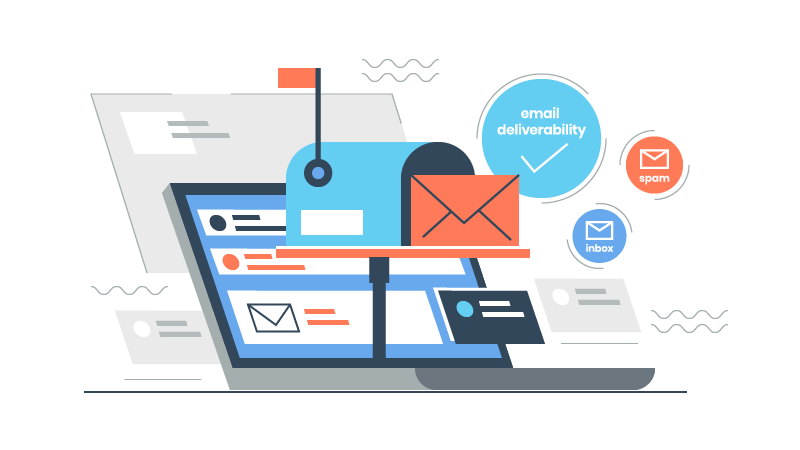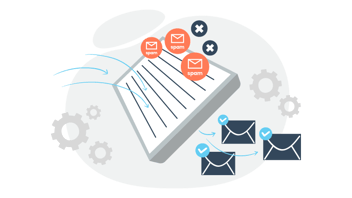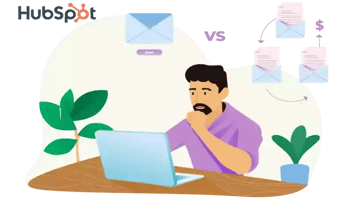Email Sequences: How Many Emails Does it Take to Get a Meeting?
Have you ever crafted the perfect email, hit send, and...silence? You're not alone. In today's overflowing inboxes, securing meetings through email outreach can feel like a frustrating battle. Busy schedules and information overload often leave your message buried beneath the digital clutter.
You can break through the noise by leveraging email sequences and improve your chances of landing a meeting.

The Importance of Email Sequences
Let's face it: Sending an email only to have it ignored can feel like a personal rejection. But before you take it personally, here's a comforting truth: people aren't deliberately ignoring your outreach. The culprit behind radio silence is often a combination of factors beyond your control.
Busy schedules are the number one enemy of email engagement. In today's fast-paced world, inboxes are overflowing, with important messages often lost in the digital fray. Additionally, a simple case of forgetting is all too common. People might genuinely intend to respond but get sidetracked by more pressing tasks.
Here's where the power of persistence comes in. While it may feel counterintuitive, sending a single email is rarely enough to cut through the noise.
Studies conducted by HubSpot reveal a surprising fact: it typically takes five follow-up emails before a prospect engages.
That's right, five! This underscores the importance of persistence in email outreach. By strategically following up, you increase the chances of your message reaching the right person at the right time.
So, how do you ensure your follow-up efforts are effective and not annoying? Enter the email sequence:
This pre-designed series of emails, spaced strategically over a set timeframe (typically 1-2 weeks), allows you to nurture leads strategically without bombarding them. Each email builds upon the previous one, offering new information or approaching the meeting request from a fresh angle. This multi-pronged approach keeps your message relevant and increases the likelihood of sparking a conversation.
Think of an email sequence as a well-rehearsed conversation, not a relentless monologue. By strategically following up and providing valuable content, you can transform frustrating outreach into a successful engagement.
Build Your Winning Email Sequence and Find Your Magic Number
Crafting a winning email sequence is the key to unlocking successful follow-up and securing those coveted meetings. Here's a roadmap to guide you through the process:
1. Structure: Number and Spacing of Emails
The ideal length of your sequence can vary depending on your audience and goals. However, a sweet spot lies between 4-6 emails, spaced strategically over a period of 1-2 weeks. This balance ensures you stay visible without becoming a nuisance.
Here's a breakdown of the typical spacing:
-
Initial Email: This is your first impression, so make it count. Send it right after establishing initial contact.
-
Follow-Up 1 & 2: These emails arrive a few days after the initial email and each other. Use them to provide additional value or address potential concerns.
-
Follow-Up 3 (Optional): This email can be sent a few days after Follow-Up 2, offering a final chance to connect before concluding the sequence.
-
Breakup Email (Optional): Consider this a friendly reminder you're still thinking of them. Sent a week or so after the last follow-up, it can be a lighthearted email with industry news or a relevant meme.
2. Content Variety: Types of Emails in a Sequence
A winning sequence doesn't rely on monotonous repetition. Here's how to inject variety and keep your prospect engaged:
-
Initial Email: Focus on a solid introduction. Briefly introduce yourself and your company, highlight your value, and propose a meeting. Keep it concise and compelling, addressing their specific needs or challenges. This is your chance to make a positive first impression, so proofread carefully before hitting send.
-
Follow-up Emails: Don't simply repeat your initial message. These emails are opportunities to provide additional value and demonstrate your expertise. Consider these strategies:
-
Offer Relevant Content: Share a blog post, case study, or infographic that addresses their pain points.
-
Address Potential Concerns: Anticipate their hesitations and address them head-on. Offer testimonials or success stories from similar clients.
-
Propose a Different Meeting Format: Suggest a shorter call or a virtual coffee chat to accommodate their schedule.
-
-
Breakup Email (Optional): This email injects a touch of lightheartedness into the sequence. Don't talk about the meeting directly. Instead, share a relevant industry news tidbit, a funny meme, or a thought-provoking question. This unexpected touch reminds them you're human and keeps your name fresh in their mind.
It can also be helpful to use proven email templates to get started. Once you have a template that aligns with your goals, you can customize it to your business and needs.
3. Leverage Personalization
People respond best to messages that feel genuine and tailored specifically to them. Personalization is the secret ingredient that elevates your emails from generic outreach to meaningful connection. Here's how to personalize your sequence:
-
Use Their Name: Addressing them by name instantly grabs their attention and adds a personal touch.
-
Reference Previous Conversations: If you've had any interaction, briefly mention it in your email. This demonstrates that you've paid attention and are genuinely interested in their needs.
-
Tailor Your Message: Don't send a one-size-fits-all template. Research their company and industry challenges. Focus on how your solution addresses their specific pain points.
4. Be Clear and Concise
Respect your prospect's time. Busy professionals don't have the luxury of wading through lengthy emails. Here's why clarity and conciseness are crucial:
-
Get to the Point Quickly: State your purpose up front. Why are you contacting them? What value do you offer?
-
Keep it Short and Sweet: Aim for emails under 300 words. Focus on delivering the essential information without unnecessary fluff.
-
Use Bullet Points and Subheadings: Break up large chunks of text for easier readability. This makes your message scannable and allows them to quickly grasp the key points.
By following these guidelines for structure, content variety, personalization, and clarity, you can craft email sequences that are both informative and engaging. These winning sequences will keep you top-of-mind and pave the way for securing those all-important meetings.
Crafting Compelling Email Content
The content within your sequence is the magic that transforms an email from a bland notification to a captivating message that sparks engagement. Here's how to craft compelling content that compels action:
Subject Lines
Your subject line is the first impression, the single line that determines whether your email gets opened or relegated to the dreaded "delete" pile. Here's how to write subject lines that grab attention:
-
Intrigue, Don't Spoil: Spark curiosity without revealing everything. "Unlocking Growth: A Strategy for [Their Industry]" is more enticing than "Meeting Request: Your Company Growth."
-
Personalize When Possible: Weave in their name or a relevant keyword to pique their interest. "John, Doubling Leads Like [Competitor]? Let's Chat." personalizes the message and stands out.
-
Keep it Short and Punchy: Aim for under 50 characters to ensure it doesn't get cut off in inboxes.
-
Avoid Spammy Tactics: Exclamation points, ALL CAPS, and excessive emojis can trigger spam filters.
Opening Lines
The opening line is your chance to hook them in. Once they open the email, you need to capture their attention quickly. Here are some strategies:
-
Ask a Compelling Question: "Are you struggling to [Their Pain Point]?" directly addresses their challenges and invites a response.
-
Start with a Bold Statement: "The marketing landscape is changing. Is your strategy keeping pace?" positions you as an industry thought leader and sparks their curiosity.
-
Offer a Relevant Statistic: "Did you know 78% of consumers base buying decisions on content?" grabs attention with a data-driven hook.
Value Proposition
Your email should be all about them, not you. The key is to focus on your value proposition. Don't simply list features; explain how those features translate to concrete benefits for their business.
-
Identify Their Challenges: Research their industry and understand their pain points.
-
Connect Features to Benefits: Show how your product or service solves those challenges. For example, instead of saying, "Our CRM offers lead tracking," say, "Streamline your sales process and boost lead conversion with our real-time tracking feature."
-
Focus on Outcomes: Highlight the positive outcomes they can achieve by working with you. Quantify results whenever possible. "Increase customer satisfaction by 20% with our user-friendly support platform."
Calls to Action (CTAs)
Don't leave your prospect guessing what to do next. Make it easy for them to take the desired action by including a clear call to action (CTA) in every email.
-
Be Specific: Don't say, "Let's connect." Instead, say, "Schedule a free 15-minute consultation today."
-
Use Strong Verbs: Words like "Schedule," "Download," or "Learn More" leave no room for ambiguity.
-
Make it Easy to Act: Include a clear link or button that directs them to the next step (e.g., scheduling page, case study download).
Closing Lines
Leave a lasting impression with a confident closing that reiterates the value you offer and expresses your hope to connect.
-
Reiterate the Value Proposition: Briefly remind them of the benefits they can gain by working with you.
-
Express Optimism: End on a positive note. Show your enthusiasm for a potential collaboration.
-
Maintain Professionalism: Thank them for their time and offer a specific time frame for a response.
By crafting clear, concise, and benefits-focused email content, you'll transform your emails from one-sided pitches to valuable conversations. That's a recipe for successful follow-up and more meetings booked.
Advanced Strategies
While a well-structured email sequence is a powerful tool, it's just one piece of the outreach puzzle. Here are some advanced strategies to elevate your email game and boost your success rate:
Leverage Social Proof
People naturally gravitate towards things endorsed by others. This is where social proof comes in. By incorporating social proof elements into your emails, you build trust and establish credibility:
-
Testimonials: Showcase quotes from satisfied customers highlighting the positive impact of your product or service.
-
Case Studies: Share real-world examples of how you've helped companies achieve success.
-
Reviews: Include positive reviews from platforms like G2 Crowd or Capterra to demonstrate your value proposition.
Strategic use of social proof within your emails reassures prospects of your legitimacy and increases the likelihood of a positive response.
Multi-channel Approach
Don't confine your outreach efforts solely to email. A multi-channel approach that combines email with other tactics can significantly improve your chances of connecting:
-
LinkedIn Outreach: Connect with your prospect on LinkedIn and send a personalized message referencing your previous email.
-
Voicemail Follow-Up: Leave a concise voicemail after a few days, summarizing your offer and suggesting next steps.
-
Social Media Engagement: Engage with them on relevant social media posts, sparking a conversation and demonstrating your industry expertise.
Utilizing various channels increases your touchpoints and creates a more cohesive outreach experience.
A/B Testing
The beauty of email marketing lies in its capacity for continuous improvement. A/B testing allows you to experiment with different elements of your emails and see what resonates best with your audience. Here's how:
-
Test Subject Lines: Try out variations of your subject line and see which ones lead to higher open rates.
-
Experiment with CTAs: Test different call-to-action formats and wording to see which ones generate the most clicks.
-
Optimize Send Times: Experiment with sending emails at different times of the day or week to determine the most favorable time frame for engagement.
Through A/B testing, you can continuously refine your email strategy and ensure your messages are optimized for maximum impact.
Targeted Outreach
The more targeted your outreach, the higher your success rate. Don't waste time sending generic emails to a broad audience.
-
Identify Your Ideal Customer Profile (ICP) and Buyer Persona: Who is your ideal client? Define their demographics, industry, and biggest pain points.
-
Utilize Available Data: Leverage CRM data or marketing automation tools to personalize your messages based on specific customer information.
-
Refine Your Sequence: Tailor your email sequence content and tone to resonate with your Buyer Persona's specific needs and challenges.
By focusing on a well-defined audience, you craft relevant and impactful email sequences, which can lead to more meaningful connections and increased meeting conversions.
The Power of 5: Unlocking Success in Email Outreach
Securing meetings through email outreach can sometimes feel like an uphill battle. Still, by embracing persistence and value-driven communication, you can significantly improve your chances of booking a meeting.
Remember, it typically takes five follow-up emails within a well-structured sequence to break through the noise and engage your prospect. This multi-pronged approach allows you to deliver value and demonstrate your expertise consistently. As a result, email recipients will be more likely to be genuinely interested in your solutions and book a meeting with your sales team.
Ready to take your email outreach to the next level? Aspiration Marketing offers email marketing tools and resources designed to help you craft high-performing email sequences and optimize your sales pipeline.
Contact us today to learn more and unlock the full potential of your email marketing efforts!
This content is also available in:
- German: E-Mail-Sequenzen optimieren: Die magische Anzahl für Termine
- Spanish: Secuencias de Emails: ¿Cuántos correos para una reunión?
- French: Réunions par email: Combien de messages pour décrocher un rendez-vous?
- Italian: Sequenze di e-mail: quante e-mail servono per ottenere un incontro?
- Romanian: Secvențe de e-mailuri: câte emailuri pentru a obține o întâlnire?
- Chinese: 电子邮件序列:需要发送多少封电子邮件才能召开一次会议?

Joachim is a certified HubSpot trainer with over 13 years of experience in content marketing, strategy, website development, and SEO. He has implemented numerous large-scale, international growth marketing programs, including one with UiPath, which grew from a startup to a successful IPO on the NYSE. Joachim has special expertise in multilingual marketing and sales enablement projects, and he uses the latest AI technologies to help our clients.








Leave a Comment